It is quite simple for the owner of a private house to adjust or repair heating radiators, because he has individual system. It is more difficult for owners of apartments where vertical single-pipe systems are arranged and any manipulations with heating devices in winter period may affect neighbors. The purpose of this article is to explain how to properly close the battery in the apartment and at the same time not harm others.
Is it possible to cover the battery in winter?
During heating season interfering with the work of centralized systems is not allowed. An exception may be various emergencies: breaks, leaks, and so on. But if the radiators are connected to the system wisely, then by shutting off the battery during the heating season, you will not freeze any of the neighbors. It means standard scheme connect the radiator with two ball valves and if there is a bypass line, as shown in the photo:
If your heaters are connected to the riser in this way, then everything is very simple: if necessary, close both taps, and after the work is done, open it again. Even if it's hot, you can turn off the battery manually for a while so as not to open the windows. Although in such situations it is better to install thermostatic valves on radiators that maintain an acceptable temperature in the room.
Thanks to correct connection heating radiator can be cut off from the system at any time of the year when necessary:
- to color it;
- perform flushing;
- change the battery without blocking the riser.

Battery emergency shutdown
And what to do when an accident occurs and hot water fills the room, and stop valves No? Or are the battery leads not connected bypass? In an emergency situation, the temporary discomfort of the neighbors will have to be pushed into the background and the water in the battery must be turned off in any way.

Indeed, as a result of a breakthrough, significant material losses can be incurred not only by you, but also by the neighbors from below, who will also get water.
Advice. If the leak is small, water just drips at the junction, then you have enough time to resolve the issue. It is necessary to substitute some kind of container and contact by phone in heat supply organization or to a house mechanic.
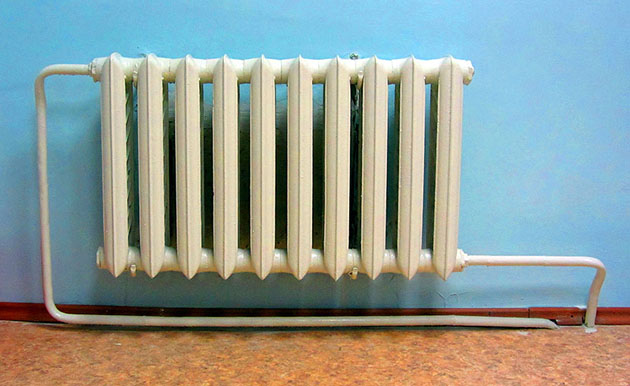
When the leak is significant and there is a danger of a flood in the room, you must act quickly. The valves on the radiator connections must be closed regardless of the absence of a bypass. If there is no fittings, then it is necessary to make calls to all possible emergency services, and then try to block the entire riser yourself before they arrive. To do this, you will have to go down to the basement of the house and find the heating point of your entrance. talking in simple words, we need to find 2 vertical pipes, going up from a horizontal collector of larger diameter.

Valves or cocks located on the tie-in of both pipes into the manifold must be closed. At the same time, not only your apartment will remain without heat, but also all the others in the riser. In a good way, you need to go through all the apartments and warn the neighbors about the current situation, and hang a sign on the closed valves so that no one opens them again while you are doing repairs. If it was not possible to find the necessary valves, then you will have to wait for the arrival of a locksmith or the arrival of an emergency service.
Conclusion. You can block your steel or cast-iron battery in the middle of winter in two cases: when the piping scheme allows it and in the event of an emergency - in any case.
About disconnecting batteries for the summer
Any water heating system must be filled with coolant all year round. The ingress of air into it due to its emptying will not lead to anything good - all steel elements will begin to actively corrode until the moisture leaves. Given the closed space, this will not happen soon, and empty pipes will be covered from the inside with a layer of rust. AT centralized systems it is impossible to understand whether there is water in the batteries in the summer, one can only hope for the good faith of the relevant services.
As practice shows, you need to rely only on yourself. Therefore, in order to extend the life of the heating devices and prevent them from being empty, it is necessary to choose the right moment at the very end of the heating season and turn off the tap on the battery installed on the outlet pipe. In the event of any repair work on heating networks, workers can drain the water from the riser, but it will not leave the closed radiator.
Advice. You can absolutely not worry about whether it is necessary to shut off the batteries in the summer, when there are cast-iron heaters in the apartment. Unlike other materials, cast iron is practically not subject to corrosion.
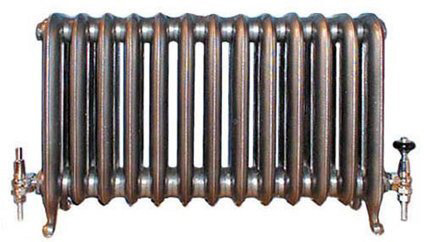
At the time of the autumn start-up of centralized heating, particles of dirt and rust move along with the coolant through pipelines. Steel, aluminum and bimetallic batteries have a small channel width, which can become clogged rather quickly. So on the first day of launch, when you hear the murmur of water in the pipes, you should not rush and open the taps. It is better to do this the next day by letting the air out with the Mayevsky crane.
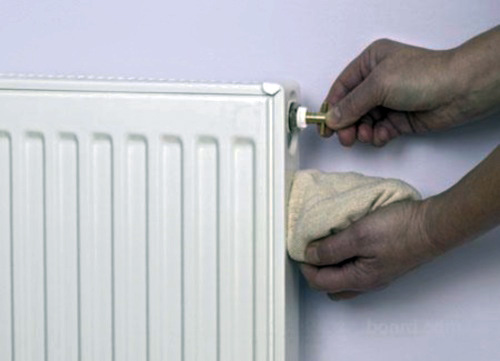
On the Internet, there is often a warning that in the summer the valve on the battery needs to be closed only one, two - in no case. Some say that after cooling, the water will decrease in volume, a vacuum will appear in the radiator, as a result of which it will crack (an example of a plastic bottle without air is given). Others broadcast that the gap will occur due to chemical reactions in aluminum batteries and the release of oxygen in all others. Excessive pressure will appear, which supposedly will break the device.
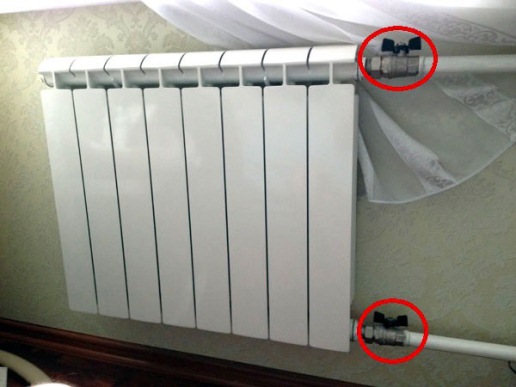
Such assertions have no basis. The lowest operating pressure- at cast iron batteries and it is 9 bar, the destructive pressure is even higher. None chemical reaction coolant with any metal will not be able to create such excess pressure, and in fact aluminum radiators the limit is even higher - 16 bar. An example with a vacuum does not stand up to criticism at all, if it suddenly forms, then the force of the external impact on the walls of the battery will be 1 Atm, that is, 1 Bar.
Conclusion
Apartment with central heating- is not a private house and the overlapping of batteries must be treated responsibly, especially in the cold season. Hence the advice: all repair and maintenance work should be carried out in the summer, with the exception of an emergency.
Every year we are faced with the problem of turning off the heating system, which occurs at the end of the season. So, let's figure out how to block the battery in the apartment correctly. To do this, you need to know some important features such systems. So, each heating network is filled with coolant, which remains in it throughout the year. The role of the heat carrier is played, as a rule, by water. In winter, the heating system is filled hot water, and in summer - cold.
Why water is not drained at the end of the heating season
- Water is constantly inside the heating system and does not allow metal to come into contact with air. Corrosion occurs when a metal comes into contact with dissolved oxygen in water;
- Due to the isolation of the heating system from the outside world, water in as soon as possible deprived of dissolved oxygen. Then, the oxidation process, which is usually a catalyst for corrosion processes, is completely eliminated.
- As a result of all this, the heating network does not rust from the inside at all, which cannot be said about pipeline system cold and hot water. However, if the water is removed from the system, then moist air with high content oxygen. This is precisely what explains why pipes and batteries rust from the inside in the absence of a coolant. (See also: )
Before shutting off the heating battery, you need to study the other side. According to established standards The heating network must always contain water. At the same time, some managing organizations, in order to save money, often neglect this requirement. So, in the process of repairs, it is necessary to drain the water from the system, and then refill the network with it, while wasting time. If batteries are replaced and repaired in several apartments in one summer, then every time you have to management company lower and fill the system. Therefore, in some cases, pipes for the summer remain without water at all. Due to the closed system, the pipes will not be able to dry out from the inside, and moisture will start corrosive processes.
We proceed to the overlap of the heating battery
In order to properly block the battery, let's pay attention to the features of its design. Modern models equipped with two taps, and if necessary, we can turn off the tap on the battery. You can use one tap, two or not touch them at all. Let's consider each of these options separately.
Another option is to shut off both taps. Is it possible to block the battery in this way? Of course not. To explain this answer, let us recall the school physics course. After the hot water is turned off, when both taps are closed, it will begin to cool. In this regard, its volume in the battery will decrease, which will lead to the formation of a vacuum. This is a very dangerous situation!

Remember, at least, what will happen to plastic bottle if the air is removed from it. It is very strongly deformed due to increased pressure. One can imagine what pressure will act on the battery of the heating system if a vacuum occurs in it. It can be deformed or even crack, which is unacceptable. Therefore, never close both taps at the end of the heating season.
How to behave when turning on the heating in the fall
In fact, in the fall it is important to properly shut off the heating battery. After you find out about the date the heating is turned on, you need to take some actions. You remember that when you turn on the heating, only rust will pass through the pipes. That is why in this case it is recommended to close both taps at the same time, which will eliminate the possibility of clogging the battery.
It is enough to leave both taps closed for one day. And do not worry if a sharp cold snap is promised the next day: the water will not cool down enough for a vacuum to form in the battery. Then you can open both taps and leave it that way until the end of the heating season, when you need to shut off the battery in the apartment again.

Battery replacement in winter
What else should you know
If you are wondering how to shut off the battery if there is no tap, then here is the solution. True, here the option of overlapping the riser is inevitable. In this case, not only a single battery will be blocked, but also part of the heating system. In cities small size the practice of independently turning off the heating is often used, just by blocking the riser. It is turned off with a valve in the basement. At that point, he approaches the bed. Plumbing valves are usually in sight.
You can find out which fittings are suitable for shutting off the heating in technical documentation. In addition, this should be known to an experienced plumber familiar with local communications. In most cases heating system closed with a brass valve or by means of a valve.
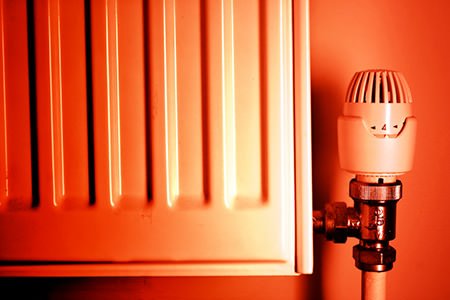
In the event that the window sill overlaps the battery, there is no single solution. It all depends on the degree of overlap. So, for example, if the window sill completely blocked the battery, then this is considered unacceptable. This is explained by the concept of convection, in which warm air rises. There he replaces cold air, which goes down, after which it heats up with a battery. Thus, the room is heated. If the window sill completely blocked the battery, then the convection process is difficult, and the room does not warm up well. But there must be a way out of this situation. You can make several rectangular holes in the windowsill and close them with decorative bars.
Let's summarize
- So, it is possible and, in some cases, even necessary to cover the batteries in the apartment. The most convenient way to do this is with special cranes.
- After the end of the heating season, it is recommended to close one of them, and leave the other open.
- On the day the heating is supplied, we close both taps for 1-2 days so that the rusty water and the possibility of blockages was eliminated.
- If there is no tap, then you will have to close the riser with a special valve or valve, which are most often located in the basement of the building, and usually in a conspicuous place.
The main thing is to do everything thoughtfully and strictly in accordance with all norms and requirements. Do not close both taps at the end of the heating season, as this may cause deformation and cracks in them. Do not forget about the basic rules that will help you shut off the battery in the apartment safely and correctly.
The use of materials is allowed only if there is an indexed link to the page with the material.
We are all used to appearance radiator - these are sections and a faucet on the side. And every time adults and parents scold children when they touch it. Quite an ordinary sight, but not everyone knows why this “faucet” is needed.
The tap on the heating battery is attached for a reason. This armature has its purpose and not one.
Functions performed
For example, it is used when they want to completely turn off the heating in a separate area of \u200b\u200bliving space. Also, the "faucet" is used in repair work and in the redevelopment of the heating system itself.
An important function of this device is to bleed air from the battery. Why important? Because due to air stagnation, hot water will not flow correctly into the radiator, which can lead to poor performance and poor heat transfer. Therefore, when installing heating appliances, a specialist will always tell you where it is better to install a tap on a battery, in which places and joints frequent air accumulation is possible.
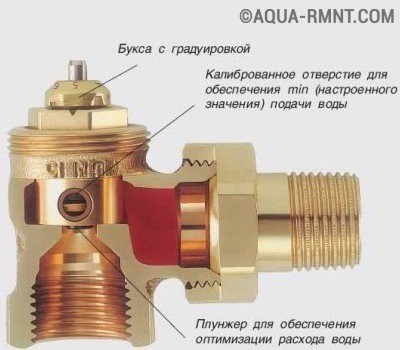
Crane in section
Buying such a crane will not take much money. The pricing policy is very acceptable, the prices for fittings vary from three hundred rubles to two thousand.
Of course, it all depends on the quality of the material used and the company. But it is worth noting that for beautiful name hides a completely ordinary item, only it costs twice as much. Therefore, before buying, you should consult with a specialist or ask your neighbors.
Starting batteries after idle time - what does it threaten?
The long-awaited start-up of hot water in the radiators after summer downtime is a big event. Residents expect heat in their apartments and houses.
But let's understand this process.
Radiators half of spring, all summer and half of autumn were not in working order. With the first start-up of water from a thermal power plant, the dirtiest, rusty water will flow through our batteries.
Of course, we do not want our radiators to become clogged from the inside. Imagine what would happen to the batteries if all this water remained inside: premature wear, rust, poor heat dissipation. But the crane will come to the rescue.
How to open the tap on the batteries and do everything right?
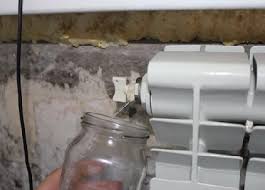
Water is draining from the battery
At the first start-up of water, slowly turn the plug and open the tap, it is advisable to substitute a bucket or basin under it, because it will flow from the radiator dirty water. I don't want to ruin the floor or carpet. An example of the descent of water can be seen in the photo.
In theory, it is necessary to drain the water for two days, then you will certainly keep the radiators safe and sound. But, as a rule, everyone is waiting for warmth and ignore this rule. Therefore, as an alternative, you can drain the water at least at night, and turn it off in the morning and enjoy the warmth and comfort in your apartment.
But do not forget about prevention. For quality work radiator, bleed air once a month.
Material on the topic of venting air and water in batteries:
Happy winter evenings!
Read also:
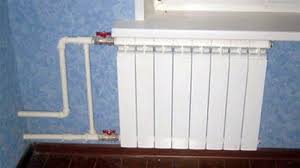 Faucets for radiators - what are and why are they needed
Faucets for radiators - what are and why are they needed
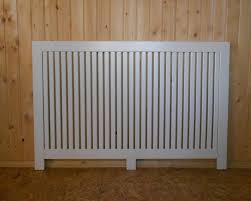 Decorative screens for radiators - why are they needed?
Decorative screens for radiators - why are they needed?
Repair work, heat in the apartment, radiator replacement - all this requires disconnecting the batteries. In this article we will tell you how to properly shut off the heating battery.
If you need to close the radiator without removing it
If you need to shut off the heating battery for the summer or turn it off due to the heat, this is easy to do if there are shut-off valves on the heating battery - ball valves. Fully turn the crank handle on the incoming and outgoing pipes. Thus, the coolant flow will be blocked.
In the photo, the taps are open. When closed, the valves of the valves are located perpendicular to the pipe.
Often there is a special adjustment valve on the inlet pipe. It can also be used to close the pipe. However, its main function is to maintain a certain temperature regime in room.
Overlapping the radiator without dismantling it is carried out in the following cases:
- Requires battery painting (during the heating season).
- The battery needs to be flushed.
- Gaskets and nipples need to be replaced.
- It is necessary to shut off the heating battery for the summer.
If necessary, close and remove the radiator
Work related to the removal of the radiator is best carried out after the end of the heating season. If work needs to be carried out during the heating season, a number of nuances must be taken into account. If you have a single-pipe heating system and vertical wiring, you can only remove the battery if there is a bypass.
Such a system can be identified by pipes, one of which comes from the ceiling and connects to the radiator, while the other exits the radiator and disappears into the floor. The bypass is a jumper connecting the incoming and outgoing pipes. This is a pipe of approximately the same or slightly smaller diameter than the main pipes. The principle of operation of the bypass is as follows: if the radiator is turned off, the water begins to flow through the riser, passing through the bypass without passing through the battery. In this case, the riser works, the heating in neighboring apartments does not turn off.
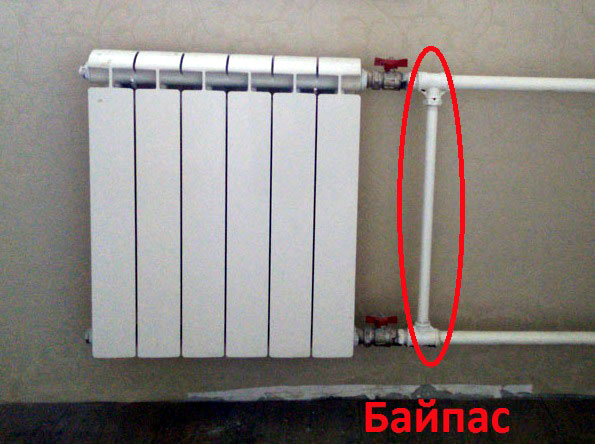
If the system is two-pipe, if there are taps, it is enough to close them, after which you can remove the battery.
Remember that the battery is always filled with water
The battery is filled with liquid throughout the year. Drainage of water is carried out only for a short time in the process of centralized repair work. Therefore, if you plan to replace the battery, just disconnecting it is not enough - you need to drain the water. Why is the system constantly filled with coolant? It is highly undesirable for oxygen to enter the heating system. When the water drains, air with water vapor takes its place. This leads to active oxidation - that is, the appearance of rust on the surface of steel and bimetallic batteries. The oxygen dissolved in the coolant does not destroy the metal; does not lead to corrosion. Therefore, in order for the heating system to last a long time, it is always full.
How to adjust the temperature in the apartment?
- If the apartment is often hot enough to make you want to turn off the radiators, consider installing temperature controllers on your radiators. If the battery has a bypass, you can put a thermostat at the battery inlet that will control the temperature in the room.
- If there is no bypass, it is forbidden to install control devices, since with such devices you will set the temperature not only in your apartment, but also for all neighbors in the riser. In this case, you can replace the heating battery and install a bypass.
Before the start of the heating season, it is necessary to check and connect the system heating in the house. Usually water heating includes separate sections pipelines and several heating radiators through which water or steam circulate. The efficiency and uninterrupted operation of the system is largely determined by the quality of the connection of heating devices and the tightness of the connections.
You will need
- — heating radiator;
- — connecting pipes;
- - Mayevsky crane;
- - set of wrenches;
- - screwdriver;
- - fasteners;
- - sealing tape.
Instruction
Before trial run heating conduct a thorough check of the entire system. Make sure the batteries heating firmly attached to their places. Today, traditional cast-iron batteries are increasingly being replaced with new multi-section aluminum radiators or bimetallic devices. Such devices are more economical, reliable and easy to use.
If you are mounting new radiator, first determine the location of its installation. Typically, radiators are mounted under the window, at a distance of at least 100-150 mm from the floor surface. Mark the places where fasteners will be placed. To fix heavy cast iron batteries, use metal hooks; attach lighter aluminum appliances with dowels and screws.
Remove the plugs from the radiator. Install the device at the mounting location in such a way that external thread connecting sleeve could go deeper into the battery case. Threaded connections carefully insulate.
Make sure that the joint is equipped with a lock nut, a special washer and a seal. If necessary, clean the mating metal parts and threaded part from rust.
Additionally, install a special air vent device on the radiator - the so-called Mayevsky crane. It allows you to remove air "plugs9raquo; from the system heating in manual mode. The specific method of fastening this device is determined by its design.
On device top wiring systems heating connect the inlet and outlet pipes on one side of the battery. If the length of horizontal sections of pipelines exceeds 150-200 mm, install spacers in the form of racks between the pipes, attaching them by welding. This will protect the connections from possible temperature deformations.
At the end of the installation of heating devices, test the system heating. Carefully inspect the connections for leaks. If necessary, restore the tightness in the places of threaded joints by laying them with tow or sealing tape.
After connecting the batteries, paint them. Not recommended for this purpose. oil paints which, when exposed to heat, darken and release volatiles. Use a special rosin varnish for painting batteries by mixing 2 parts by mass of rosin and 3 parts of turpentine. This treatment will significantly extend battery life.
related news
How to start heating in the apartment
Availability individual heating is now the norm in most cities. For newly commissioned systems, there are no requirements for preparation for the heating season.
For systems that have been in operation for a long time (more than a year), it is advisable to take a number of actions before starting the heating circuit in order to prevent system failure and increase the efficiency of space heating.
First of all, you need to check those pipes and communications that are located directly on the street. To do this, you will need a bulldozer and an excavator to dig a trench and check the integrity and safety of the pipes. If necessary, they should be replaced or patched.
Separately, it is worth considering the situation when, for some reason, the water from the system was completely drained.
How to start heating in the absence of water in the system
When starting the heating system with a complete absence of water in the system, it is necessary to follow a certain sequence of actions so as not to damage the boiler. It should be clarified that in the absence of water in heating circuit You can't use hot water either.

The start-up must be started by opening the water intake valve on the boiler, with the help of which water from the water supply is pumped into the heating circuit. In this case, the heating circuit must be switched off. It is necessary to wait until the pressure gauge installed on the boiler shows at least 1.2 atmospheres, and then turn on the heating circuit to pump water into the pipe system using a pump. The tap must be kept open until the pressure gauge shows 1.5 atmospheres with the heating turned on, then close the water intake tap and proceed to bleed air from the batteries. Before bleeding, it is advisable to wait for the water to warm up in order to determine the scale of its airing by the temperature of the battery. Having unscrewed the valve to bleed air on the battery, it is necessary to control the output airlock and as a continuous flow of water appears, close the tap. After bleeding air from one battery, it is necessary to draw water into the system using the water intake valve on the boiler to reach a pressure of 1.5 atmospheres, then make sure that the battery from which air has just been bled is evenly heated, and then proceed to remove air plugs from the rest batteries. After airing each, it is desirable to draw water into the system. In any case, the pressure should not be allowed to fall below 1 atmosphere.
How to start heating when there is water in the system
If the heating circuit was simply switched off for warm time year, and now it is necessary to turn it on again, such voluminous manipulations will not be required. It will only be necessary to turn on the heating on the boiler and, by opening the water intake valve, bring the pressure in the system to a value of 1.3-1.4 atmospheres. The possibility of batteries blowing up in this case is virtually excluded, since when hot water is turned on, the water pump is also turned on, which forced circulation water in the system. If uneven heating of the battery is detected (the battery is hot only near the inlet pipe with hot water), which indicates the presence of an air lock, bleed the air as described above.
You may be interested in:
How to shut off the heating battery?
Repair work, heat in the apartment, radiator replacement - all this requires disconnecting the batteries. In this article we will tell you how to properly shut off the heating battery.
If you need to close the radiator without removing it
If you need to shut off the heating battery for the summer or turn it off due to the heat, this is easy to do if there are shut-off valves on the heating battery - ball valves. Fully turn the crank handle on the incoming and outgoing pipes. Thus, the coolant flow will be blocked.

In the photo, the taps are open. When closed, the valves of the valves are located perpendicular to the pipe.
Often there is a special adjustment valve on the inlet pipe. It can also be used to close the pipe. However, its main function is to maintain a certain temperature in the room.
Overlapping the radiator without dismantling it is carried out in the following cases:
- Requires battery painting (during the heating season).
- The battery needs to be flushed.
- Gaskets and nipples need to be replaced.
- It is necessary to shut off the heating battery for the summer.
If necessary, close and remove the radiator
Work related to the removal of the radiator is best carried out after the end of the heating season. If work needs to be carried out during the heating season, a number of nuances must be taken into account. If you have a single-pipe heating system and vertical wiring, you can only remove the battery if there is a bypass.
Such a system can be identified by pipes, one of which comes from the ceiling and connects to the radiator, while the other exits the radiator and disappears into the floor. The bypass is a jumper connecting the incoming and outgoing pipes. This is a pipe of approximately the same or slightly smaller diameter than the main pipes. The principle of operation of the bypass is as follows: if the radiator is turned off, the water begins to flow through the riser, passing through the bypass without passing through the battery. In this case, the riser works, the heating in neighboring apartments does not turn off.
If the system is two-pipe, if there are taps, it is enough to close them, after which you can remove the battery.
Remember that the battery is always filled with water
The battery is filled with liquid throughout the year. Drainage of water is carried out only for a short time in the process of centralized repair work. Therefore, if you plan to replace the battery, just disconnecting it is not enough - you need to drain the water. Why is the system constantly filled with coolant? It is highly undesirable for oxygen to enter the heating system. When the water drains, air with water vapor takes its place. This leads to active oxidation - that is, the appearance of rust on the surface of steel and bimetallic batteries. The oxygen dissolved in the coolant does not destroy the metal; does not lead to corrosion. Therefore, in order for the heating system to last a long time, it is always full.
How to adjust the temperature in the apartment?
- If the apartment is often hot enough to make you want to turn off the radiators, consider installing temperature controllers on your radiators. If the battery has a bypass, you can put a thermostat at the battery inlet that will control the temperature in the room.
- If there is no bypass, it is forbidden to install control devices, since with such devices you will set the temperature not only in your apartment, but also for all neighbors in the riser. In this case, you can replace the heating battery and install a bypass.
Other related articles:
JavaScript is currently disabled. Please enable it for a better experience of Jumi.
How to shut off the heating battery if it gets hot
It will be necessary to shut off the batteries when the heating is turned off for the summer period, before the start of the heating season to repair or replace radiators, and also when the heat is in the apartment. We are interested in the question of how to properly close the battery if it is hot in the room. This is not difficult to do if there is an ingenious device called a bypass - jumpers between the supply and discharge pipes, very often equipped with shutoff valves and a heat regulator. The zealous owners of the apartment provide for the opportunity to turn off the water and arrange bypasses during the installation of heating devices.
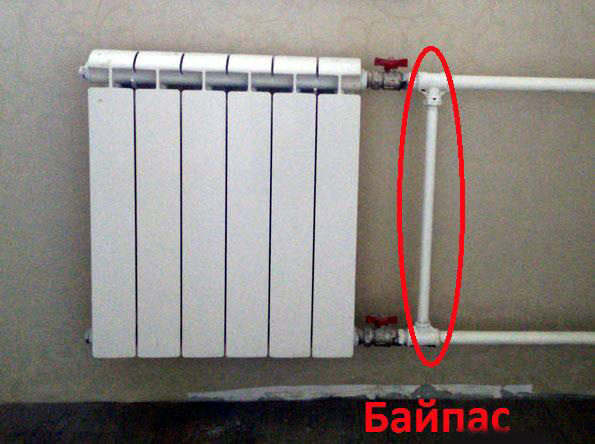
Bypass on the radiator
The bypass allows you to carry out repairs even in winter, when hot water circulates in the system. To do this, just close the tap in front of the battery, hot water stops flowing, and circulation is directed through the bypass. Thus, you do not need to go down to the basement to temporarily block the system, create inconvenience to neighbors, because you will need to turn off the riser for the entire time of repair work. The best solution is to install an additional shut-off valve at the entrance to the heating system of the apartment.

Installing a bypass with thermostat
Attention! To prevent corrosion, the system must always be filled with water, so when replacing pipes and batteries, it is necessary to turn off the water. In winter, precautions should be taken to avoid burns from hot water.
Bypass device and its functions
In winter, blocking the common riser is not allowed, the only exception is emergency situations. The presence of a bypass allows you to carry out repairs without turning off the heating system of your neighbors. The device is arranged from pipes with a smaller diameter than the supply and discharge lines. Two ball valves allow you to properly close the battery and in case it is hot, directing the circulation of water through the bypass.
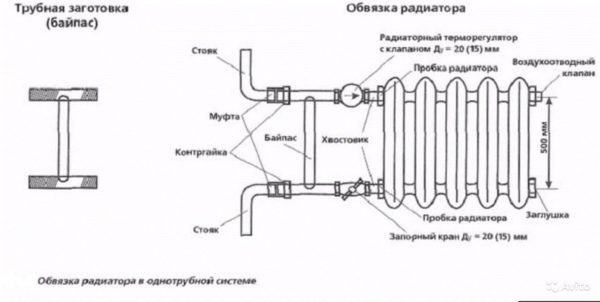
When replacing the radiator, the water is blocked, and after completion of work, it opens again. If the room is hot, the bypass again allows you to temporarily shut off the system: hot water stops flowing into the battery and the room cools down. But it is better to install thermostatic valves that maintain normal temperature in the room.
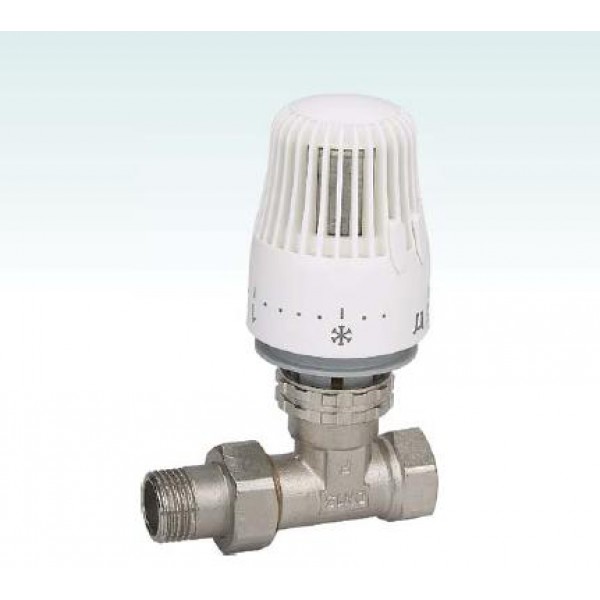
With such a device, the radiator can be properly disconnected from the system at any time when painting, flushing, battery replacement, and when changing gaskets and nipples are required without closing the risers.

Correct Bypass Installation
The bypass functions, depending on the type of heating system, are as follows:
- Energy regulation. When the room temperature is above normal, the thermostat reduces the supply of hot water, which adversely affects the operation of the entire system. This device serves to return the coolant that has not entered the battery to the system.
- Emergency regulation of the coolant circulation in the system with electric pump. When there is a power failure, the bypass with a valve shuts off the hot water supply to the pump through the bypass pipe, at this time the valve opens and the coolant is directed through the central pipe. So in a simple way the system goes into a state of natural circulation without the participation of the pump.
- resuscitation single pipe system. It works quite effectively: the apartments are warm, even hot. The bypass also helps in this situation, allowing you to reduce the supply of hot water, thus acting as a thermostat.

Thermostat on the radiator
The bypass must be installed near the radiator. It is recommended to fabricate the bypass pipe on site during installation using welding machine. You can also use ready-made equipment for threaded connections. control valve or radiator thermostat must be located between the radiator inlet and the bypass.
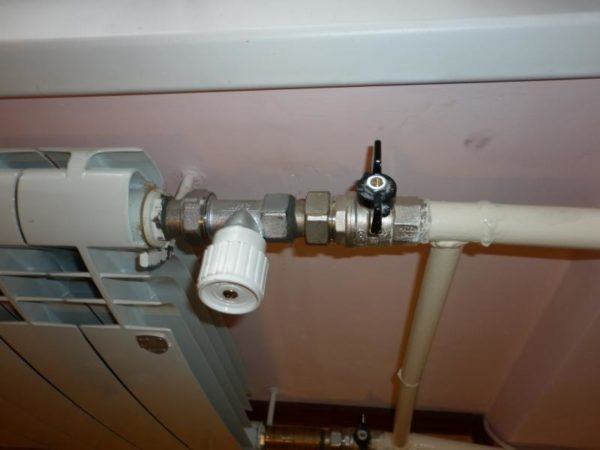
The supply side is equipped with a valve with a thermal head.
Energy consumption for a bypass pipe with a thermostat
Installing a thermostat has a positive effect on energy costs. Compared with a conventional flow pipe, the bypass pipe system reduces hot water consumption by 30-35% and heat output of the radiator is reduced by 10%. This is of no small importance with an excess of heat in the heating system, that is, when the apartment is hot. This indicates the effectiveness of the system using the bypass to create indoor comfortable conditions, and the payment for energy consumption is significantly reduced.
What are heat regulators?
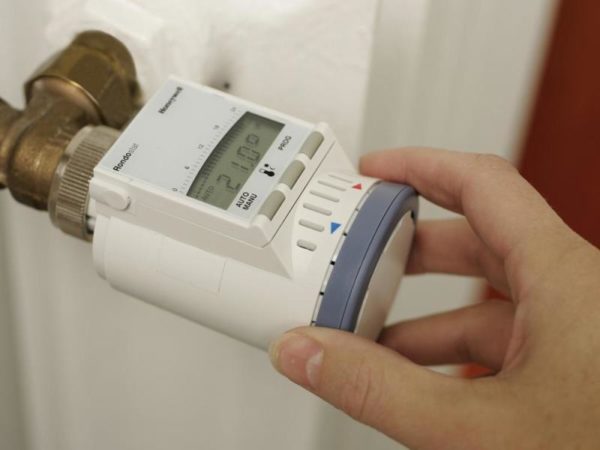
Electronic thermostat on the radiator
The heat regulator is a special control valve that controls the amount of water entering the battery. Usually five positions of the regulator are set, when it is fully open, the valve opening matches the diameter of the pipe, hot water enters the radiator in in full. When the valve is fully closed, water stops flowing into the battery.
Attention! It is impossible to install thermostats without jumpers. With a decrease in the volume of hot water entering the radiator, its flow through the entire system is reduced, which is unacceptable. The presence of jumpers ensures the circulation of water without any obstacles.

Garbage and dirt in the radiator
In addition, jumpers protect the thermostat from clogging during the first connection, as well as accidents on the heating main. The valve must be located after the jumper, in which case it will be sufficiently protected from contamination. Do not forget that the thermostat is not adapted to pollution. As a result, the formation of a congestion that does not allow hot water on batteries, and this is fraught with the capture of the entire riser. Therefore, jumpers should be left open at all times, except when the radiators are clogged and need to be flushed. In this case, the valves are closed for the time of washing the batteries, and then open again.
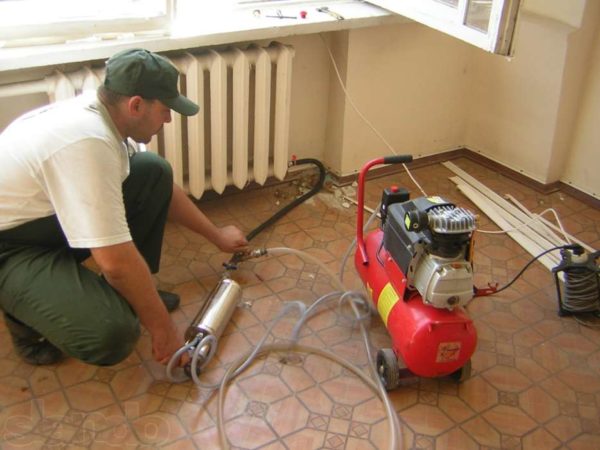
Cleaning and flushing radiators
Battery emergency shutdown
If an emergency situation has developed in the absence of shutoff valves and a bypass, the water is shut off by turning off the riser in the basement, otherwise not only your apartment, but also the neighbors living below will be flooded with water.
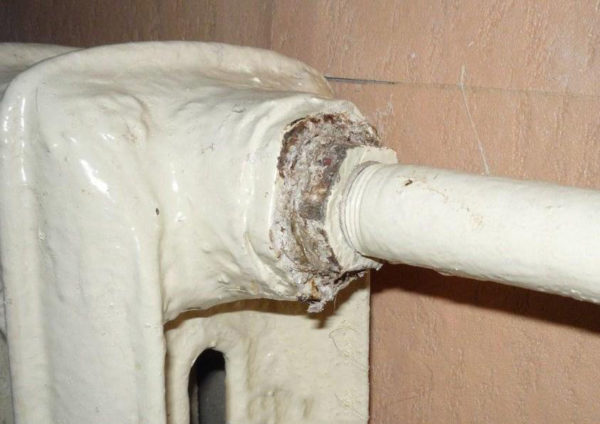
Advice. When water leaks, you need to act depending on the nature of the accident: if the leak is local and there is time to wait for a specialist, it is enough to substitute a container to prevent consequences and call emergency service. If the accident is threatening, it is required to immediately turn off the water in the riser.
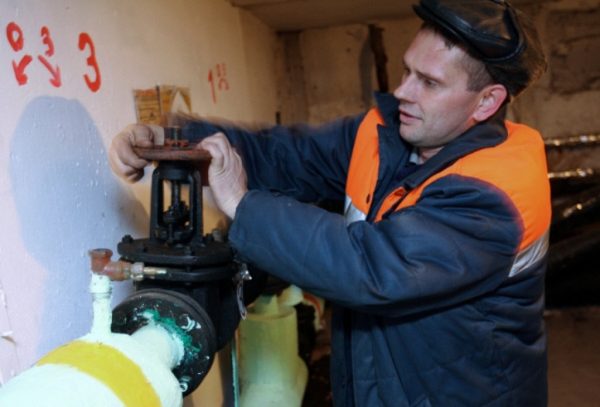
Shutdown of the heating riser
It can be concluded that when planning a heat supply system great importance has a timely provided possibility of overlapping batteries using a bypass pipe with a thermostat.
Photo gallery (11 photos)
Possible schemes for connecting heating radiators
In order for the house to be warm, it is important to correctly develop a heating scheme. One of the components of its effectiveness is the connection of heating radiators. Whether cast iron, aluminium, bimetal or steel radiators you are going to bet, it is important to choose The right way their connections.

The way the radiator is connected affects its heat dissipation.
Types of heating systems
The amount of heat that a heating radiator will radiate depends not least on the type of heating system and the type of connection chosen. To choose best option, you must first understand what kind of heating systems are and how they differ.
Single pipe
One-pipe heating system - the most economical option in terms of installation costs. Therefore, this type of wiring is preferred in high-rise buildings, although in private such a system is far from uncommon. With such a scheme, the radiators are connected in series to the line and the coolant first passes through one heating part, then enters the second one, and so on. The output of the last radiator is connected to the input of the heating boiler or to the riser in high-rise buildings.

Example of a one-pipe system
The disadvantage of this wiring method is the impossibility of adjusting the heat transfer of radiators. By installing a regulator on any of the radiators, you will regulate the rest of the system. The second significant drawback is the different temperature of the coolant on different radiators. Those that are closer to the boiler heat up very well, those that are further away become colder. This is a consequence of the series connection of heating radiators.
Two-pipe wiring
A two-pipe heating system is distinguished by the fact that it has two pipelines - supply and return. Each radiator is connected to both, that is, it turns out that all radiators are connected to the system in parallel. This is good in that a coolant of the same temperature enters the inlet of each of them. Second positive moment- on each of the radiators, you can install a thermostat and use it to change the amount of heat that it emits.
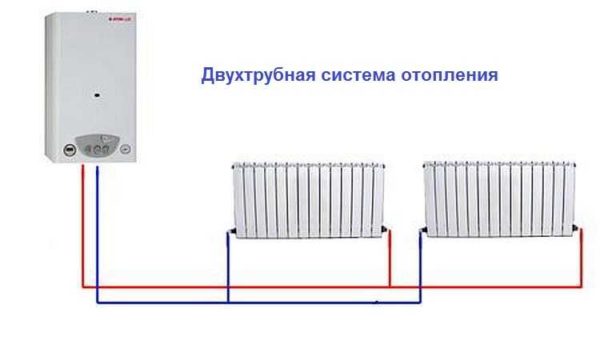
The disadvantage of such a system is that the number of pipes when distributing the system is almost twice as large. But the system can be easily balanced.
Where to put radiators
Traditionally, heating radiators are placed under the windows and this is no coincidence. updraft warm air cuts off the cold that comes from the windows. In addition, warm air heats the windows, preventing condensation from forming on them. Only for this it is necessary that the radiator occupies at least 70% of the width of the window opening. Only in this way the window will not fog up. Therefore, when choosing the power of radiators, select it so that the width of the entire heating battery is not less than the specified value.
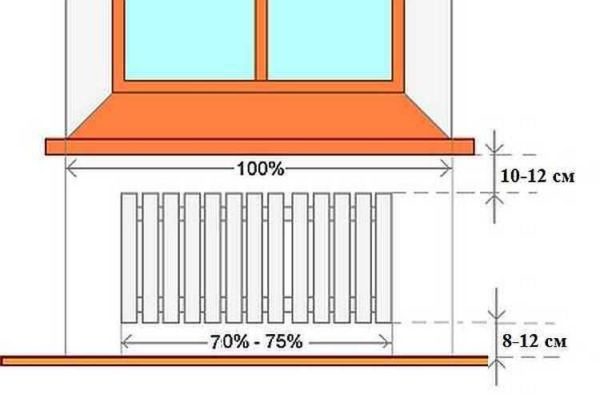
How to place a radiator under a window
In addition, it is necessary to correctly choose the height of the radiator and the place for its placement under the window. It must be placed so that the distance to the floor is in the region of 8-12 cm. If lowered, it will be inconvenient to clean, if raised higher, the feet will be cold. The distance to the window sill is also regulated - it should be 10-12 cm. In this case, warm air will freely go around the barrier - the window sill - and rise along the window glass.
And the last distance that must be maintained when connecting heating radiators is the distance to the wall. It should be 3-5 cm. In this case, along rear wall radiator, ascending currents of warm air will rise, the rate of heating the room will improve.
Radiator connection diagrams
How well the radiators will heat up depends on how the coolant is supplied to them. There are more and less effective options.
Radiators with bottom connection
All heating radiators have two types of connection - side and bottom. FROM bottom connection there can be no differences. There are only two pipes - inlet and outlet. Accordingly, on the one hand, a coolant is supplied to the radiator, on the other hand it is removed.

Lower connection of heating radiators with one-pipe and two-pipe system heating
Specifically, where to connect the supply, and where the return is written in the installation instructions, which must be available.
Radiators with side connection
At lateral connection there are many more options: here the supply and return pipelines can be connected to two pipes, respectively, there are four options.
Option number 1. Diagonal connection
Such a connection of heating radiators is considered the most effective, it is taken as a standard, and this is how manufacturers test their heaters and the data in the passport for thermal power - for such an eyeliner. All other connection types are less efficient at dissipating heat.

Diagonal connection diagram for heating radiators with a two-pipe and one-pipe system
All because at diagonal connection batteries, the hot coolant is supplied to the upper inlet on one side, passes through the entire radiator and exits from the opposite, lower side.
Option number 2. Unilateral
As the name implies, pipelines are connected on one side - supply from above, return - from below. This option is convenient when the riser runs on the side of heater, which often happens in apartments, because it is this type of connection that usually prevails. When the coolant is supplied from below, such a scheme is used infrequently - it is not very convenient to arrange pipes.
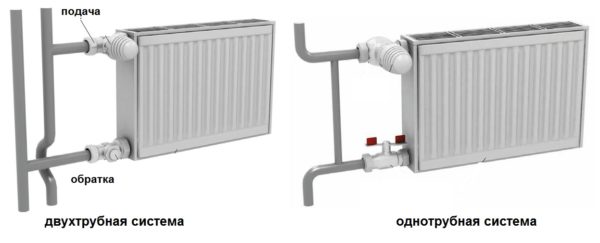
Lateral connection for two-pipe and one-pipe systems
With this connection of radiators, the heating efficiency is only slightly lower - by 2%. But this is only if there are few sections in the radiators - no more than 10. With a longer battery, its farthest edge will not heat up well or even remain cold. AT panel radiators to solve the problem, they put flow extensions - tubes that bring the coolant a little further than the middle. The same devices can be installed in aluminum or bimetal radiators while improving heat dissipation.
Option number 3. Bottom or saddle connection
Of all the options, the saddle connection of heating radiators is the most inefficient. Losses are approximately 12-14%. But this option is the most inconspicuous - the pipes are usually laid on the floor or under it, and this method is the most optimal in terms of aesthetics. And so that the losses do not affect the temperature in the room, you can take a radiator a little more powerful than required.
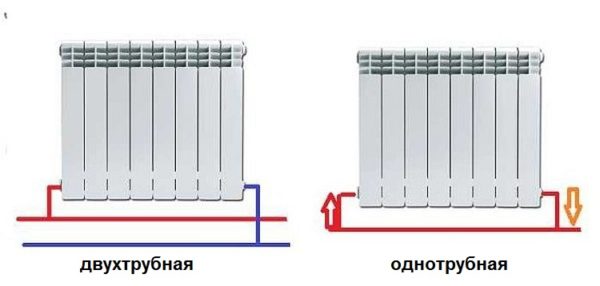
Saddle connection of heating radiators
In systems with natural circulation this type of connection is not worth doing, but if there is a pump, it works well. In some cases, even worse than the side. It's just that at some speed of movement of the coolant, vortex flows arise, the entire surface heats up, and heat transfer increases. These phenomena have not yet been fully studied, therefore it is not yet possible to predict the behavior of the coolant.


















